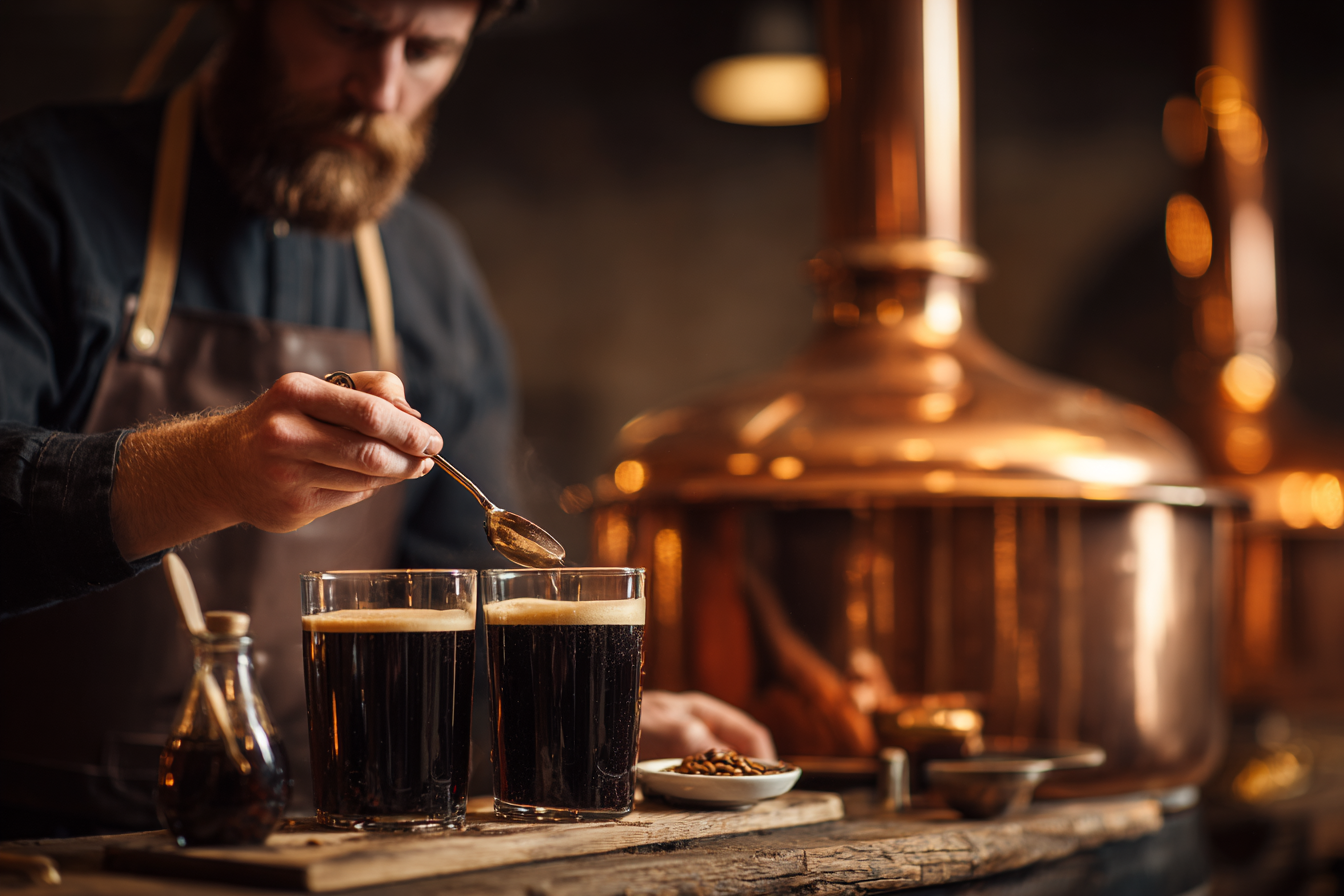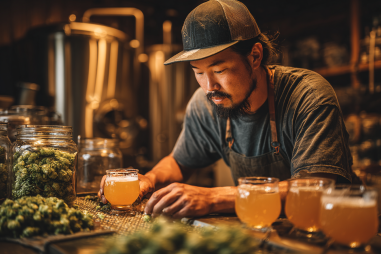The Foreign Export Stout stands tall among the world’s darker beers, celebrated for its bold flavor and robust character. Known for its deep black color, complex malt profile, and often higher alcohol content compared to standard stouts, this beer style brings an enticing richness that appeals to stout lovers everywhere. Mastering the Foreign Export Stout brewing process involves much more than just following a recipe — it’s about understanding each step, from malt selection to fermentation, to create a harmonious and flavorful brew. This article will guide you through the intricate brewing process of this captivating style, ensuring that your next batch is nothing short of exceptional.
Introduction to Foreign Export Stout
Foreign Export Stouts are a traditional style originating from England but refined and popularized in export markets, especially in Eastern Europe and the Caribbean. These beers are brewed with an intense focus on malt complexity and full-bodied flavor, often matured to develop depth and smoothness. Compared to standard porters or stouts, Foreign Export Stouts boast a higher gravity and alcohol content, typically ranging between 6% to 8% ABV or more, allowing them to withstand long export journeys without compromising quality.
History and Characteristics of the Style
The origins of Foreign Export Stouts trace back to the 19th century when British brewers sought to create strong, robust beers intended for export to far-flung regions. These stouts needed to be resilient to the rigors of shipping and storage while maintaining their flavor integrity. Over time, the style evolved into a darker, richer stout with pronounced roasted malt flavors, subtle bitterness, and a warming alcohol presence.
Characteristics that define the Foreign Export Stout include:
- Dark brown to black color with a thick, creamy tan head
- A strong malt backbone featuring roasted, chocolate, and coffee notes
- Moderate to assertive hop bitterness that balances malt sweetness
- A warming alcohol profile without overpowering the malt flavors
- A smooth mouthfeel with medium to full body
This style invites drinkers to savor every sip, often revealing new layers of flavor as it warms in the glass.
Selecting the Ingredients: Malts, Hops, Yeast, and Water
The foundation of any great Foreign Export Stout lies in the careful selection of ingredients. Each component plays a critical role in shaping the final flavor, aroma, and mouthfeel of the beer.
Malts
The malt bill for a Foreign Export Stout is dominated by base malts such as pale ale malt or Maris Otter, which provide fermentable sugars and a solid backbone. Specialty roasted malts including roasted barley, chocolate malt, and black malt contribute the characteristic dark color and robust roasted flavors. Some brewers also incorporate crystal or caramel malts to add sweetness and complexity, balancing the roastiness with hints of toffee or dark fruit.
Hops
While the malt profile takes center stage, hops are essential for balancing the sweetness and providing a subtle bitterness. English hop varieties like Fuggle, East Kent Goldings, and Target are commonly used for their earthy, herbal, and slightly floral notes. The hop bitterness is moderate—enough to complement but not dominate the malt character.
Yeast
A clean, well-attenuating ale yeast strain is preferred to allow malt flavors to shine through without excessive fruity esters or phenols. English ale strains or Irish ale yeasts are popular choices, contributing subtle complexity and smoothness to the beer’s finish.
Water
Water chemistry significantly influences stout brewing. A moderate sulfate-to-chloride ratio helps maintain balance between hop bitterness and malt sweetness. Slightly soft to moderately hard water is ideal, with attention to controlling bicarbonate levels to prevent harshness from roasted malts.
Mashing Techniques for Stout Flavor Extraction
The mashing process extracts sugars, flavors, and colors from the malted grains. For Foreign Export Stouts, the goal is to maximize malt character and body without introducing harshness.
Typically, a single infusion mash between 65°C to 68°C (149°F to 154°F) is effective for achieving medium to full body and a good balance of fermentable and dextrinous sugars. Some brewers opt for a two-step mash—starting with a lower temperature rest to encourage dextrin production, followed by a higher temperature step to optimize enzyme activity and sugar extraction.
Extended mash times of 60 to 90 minutes ensure thorough conversion of starches and enhance malt complexity.
Boiling, Hopping, and Wort Preparation
After mashing, the wort is boiled to sterilize and concentrate flavors. The boiling phase is crucial for hop addition timing and wort clarity.
Initial bittering hops are typically added at the start of the 60- or 90-minute boil to extract bitterness that counters the malt’s sweetness. Late hop additions near the end of the boil preserve subtle hop aroma without overwhelming the roasted malt character.
Vigorous boiling promotes the Maillard reaction, slightly deepening the beer’s color and contributing to the complex caramel and roasted flavors. Whirlfloc or other fining agents may be used to improve clarity, although Foreign Export Stouts are traditionally somewhat opaque due to their malt bill.
Fermentation Specifics for Foreign Export Stout
Once cooled, the wort is pitched with yeast under controlled conditions. Maintaining a fermentation temperature around 18°C to 20°C (64°F to 68°F) is ideal for English ale strains, fostering clean ester profiles and efficient attenuation.
Fermentation typically lasts 7 to 14 days, depending on gravity and yeast health. Monitoring specific gravity throughout helps brewers gauge fermentation progress and decide when to proceed to maturation.
For higher gravity Foreign Export Stouts, some brewers employ yeast nutrient additions or oxygenate the wort to support healthy yeast activity and minimize off-flavors.
Maturation and Conditioning
Maturation is critical for marrying flavors and smoothing out any rough edges introduced during fermentation. Foreign Export Stouts benefit from extended conditioning, often ranging from 4 to 12 weeks at cooler temperatures (8°C to 12°C or 46°F to 54°F).
This period allows harsh alcohol notes to mellow, roasted bitterness to integrate, and complex malt flavors to develop fully.
Some brewers choose to barrel-age or add adjuncts such as vanilla, chocolate, or coffee during conditioning for unique variations, but the classic version relies on pure malt and yeast character.
Quality Control and Common Brewing Challenges
Producing a consistently excellent Foreign Export Stout requires close attention to quality control throughout the process. Key areas to monitor include:
- Gravity and pH levels: Ensuring proper mash conversion and wort composition.
- Fermentation health: Pitch appropriate yeast quantities and maintain suitable temperatures.
- Clarity and haze: Controlling proteins and polyphenols to avoid unwanted haze without stripping malt character.
- Off-flavors: Watch for unwanted sourness, diacetyl, or solvent-like aromas due to stressed yeast or contamination.
- Carbonation: Achieve the ideal level to enhance mouthfeel without overpowering the bold malt flavors.
Common challenges when brewing Foreign Export Stouts include balancing bitterness with malt sweetness and avoiding excessive astringency from overuse of roasted malts. Patience during maturation also plays a vital role in achieving the desired smoothness.
Serving and Storage Tips
Serving a Foreign Export Stout at its best showcases all the nuances developed during brewing and conditioning:
- Temperature: Serve between 12°C to 15°C (54°F to 59°F) to unlock complex aromas and flavors.
- Glassware: Use a tulip or snifter glass to concentrate aromas and enhance tasting experience.
- Pouring: Pour gently to preserve the creamy head, which adds to the mouthfeel and aroma release.
- Storage: Store in a cool, dark environment to prevent oxidation and light damage, which can alter flavor.
Foreign Export Stouts often improve with age for several months, but are best enjoyed within a year of brewing to appreciate their freshness and vibrancy.
Crafting the Perfect Foreign Export Stout
Mastering the Foreign Export Stout brewing process is a rewarding venture for any brewer passionate about rich, complex beer. From carefully selecting malt varieties to applying precise mashing techniques, balancing hops, and managing fermentation and maturation, each step contributes to the depth and character that define this style.
Embrace both the science and art of brewing, allowing patience and attention to detail to guide you. Whether you are crafting a classic English-inspired stout or adding your own twists, understanding the fundamentals behind this storied style will set you on the path to brewing a memorable Foreign Export Stout that stout enthusiasts will savor again and again.







